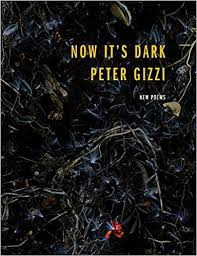Terence Diggory at Salmagundi:
 An especially mysterious manifestation of the materiality of language in these poems is the projection of voice from, or into, the material world. Repeatedly, at special moments, things speak: “the hollyhocks spoke”; “Freezing rain with silver seems to be speaking”; “these colors speak”; “The sky speaks to me”; “The roofs speak”; “the room alive speaks when the corpse speaks… and the earth speaks”; “the trees and grass are speaking”; “the old sun / is speaking.” This eruption of voice from things—Gizzi calls it “thinging,” in a pun on “singing”—seems to mark that recovery of the world that Gizzi associates with elegy in the second “Now It’s Dark” poem. However, in the volume Now It’s Dark, that recovery is purchased at the price of another loss, that of “the speaking subject,” as it is called in psycholinguistic theory, or the one who says “I,” in the traditional view of lyric poetry. Drawing on that theory, Language writers accused lyric poetry of escaping into an illusory interior world inhabited by an equally illusory “I.”
An especially mysterious manifestation of the materiality of language in these poems is the projection of voice from, or into, the material world. Repeatedly, at special moments, things speak: “the hollyhocks spoke”; “Freezing rain with silver seems to be speaking”; “these colors speak”; “The sky speaks to me”; “The roofs speak”; “the room alive speaks when the corpse speaks… and the earth speaks”; “the trees and grass are speaking”; “the old sun / is speaking.” This eruption of voice from things—Gizzi calls it “thinging,” in a pun on “singing”—seems to mark that recovery of the world that Gizzi associates with elegy in the second “Now It’s Dark” poem. However, in the volume Now It’s Dark, that recovery is purchased at the price of another loss, that of “the speaking subject,” as it is called in psycholinguistic theory, or the one who says “I,” in the traditional view of lyric poetry. Drawing on that theory, Language writers accused lyric poetry of escaping into an illusory interior world inhabited by an equally illusory “I.”
more here.
